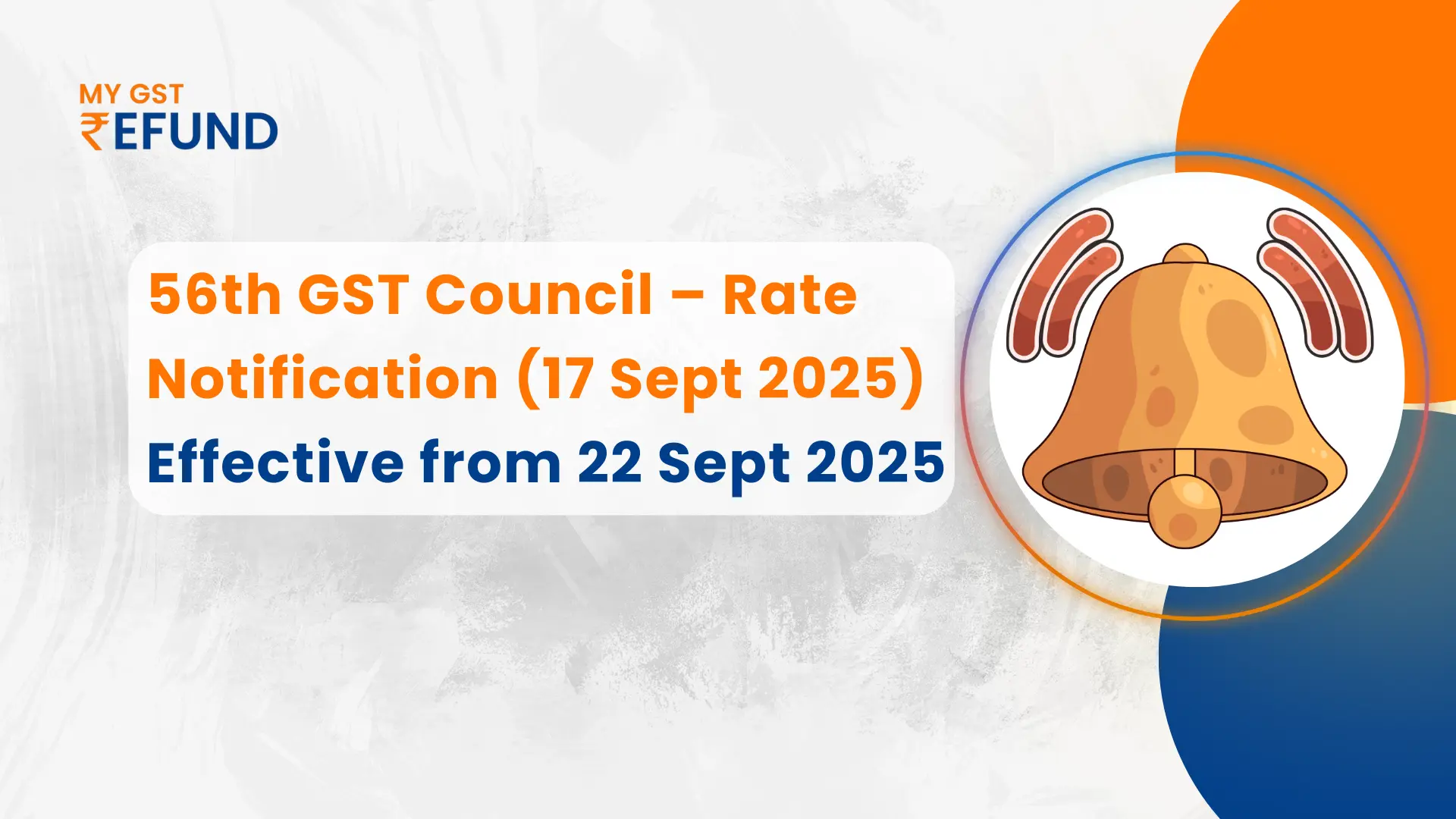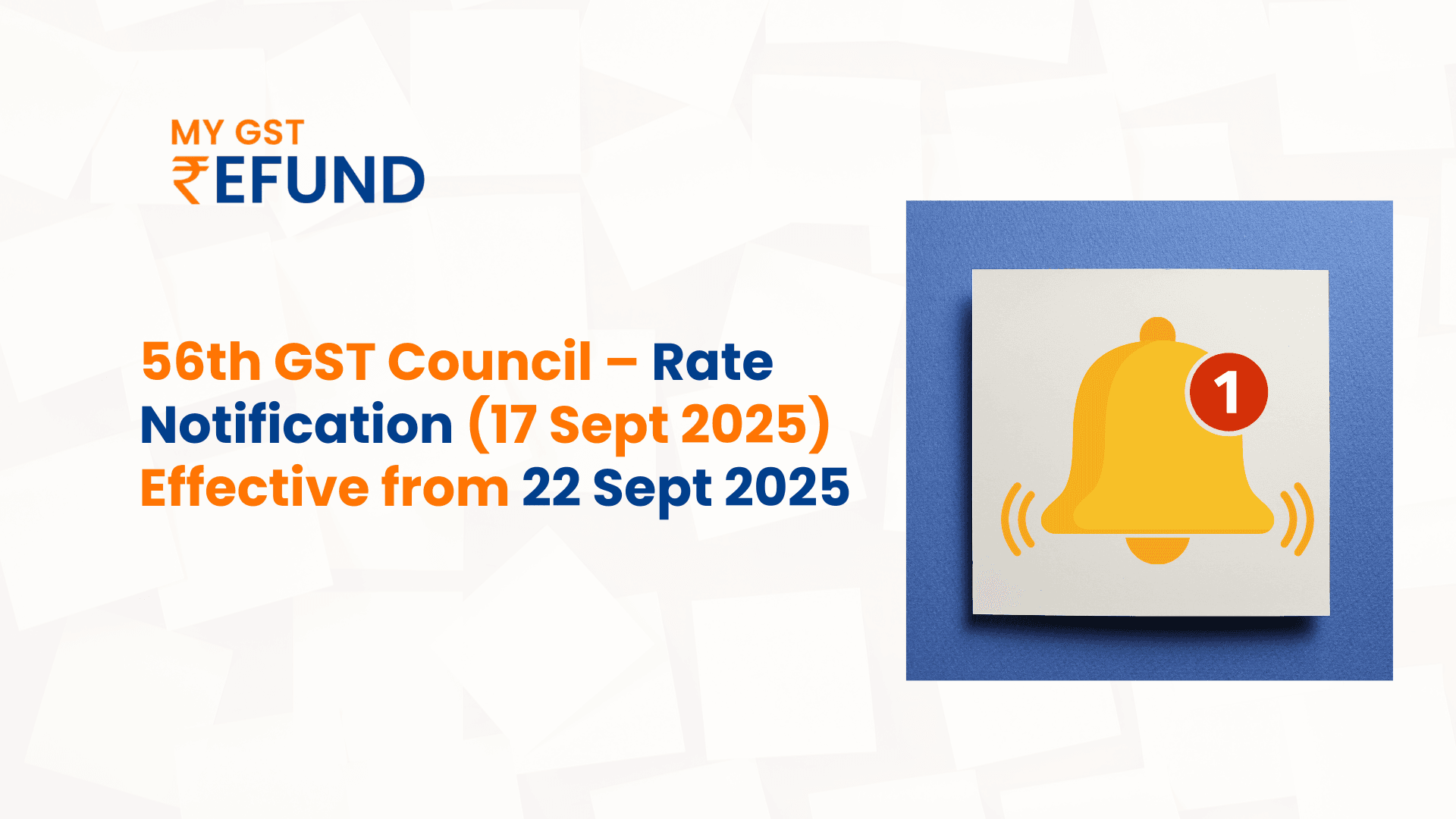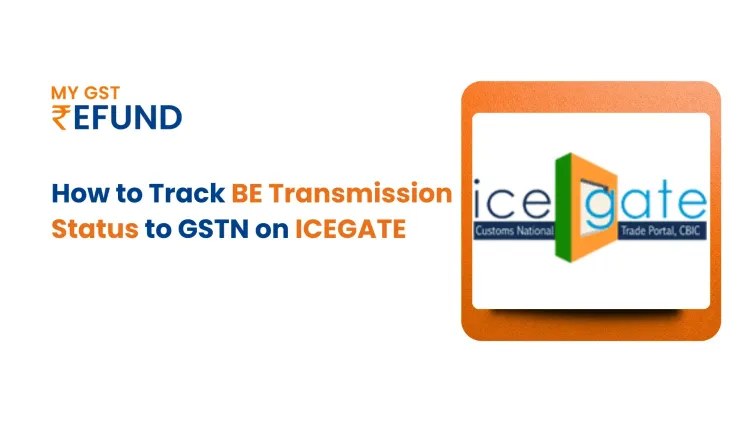Everyday Items Get Cheaper: 56th GST Council Cuts Rates on Essentials
Published on: Fri Sep 19 2025
Bio (Reveal/Hide)

56th GST Council rate notification: Key changes effective from 22 Sept 2025
On 17 September 2025, the Central Board of Indirect Taxes & Customs (CBIC) released the official notifications putting into effect the proposals of the 56th GST Council meeting. The reforms, as referred to as GST 2.0, take effect on 22 September 2025 for nearly all goods and services.
Purpose of the Notification
The call for GST 2.0, or rate rationalization, is a response to the necessity to make India's Goods and Services Tax (GST) a simpler system. Its current form, implemented in 2017, was described as too complex and caused many problems.
What Was the Revision For?
The primary purpose of suggesting the GST 2.0 is to fill the loopholes of the current taxation system. The government wants to make the system simpler with less tax slabs and eliminate issues that have caused controversy and an ineffective tax system. The purpose is to make GST a more efficient and business-friendly tax system.
The Previous Structure and Its Issues
The original GST structure featured four broad tax slabs of 5%, 12%, 18%, and 28%. Special rates were also given on some items, such as precious stones (0.25%) and gold (3%), and a zero-rate slab was offered for essentials. Although the idea was to achieve revenue neutrality by keeping goods and services at a corresponding tax slab as under the old tax regime, the multi-slab system had several issues:
Simplification of Classification and Less Litigation
One of the distinguishing aspects of the changes is the shift to a streamlined two-slab structure, which is aimed at preventing classification disputes and the threat of litigation. By reducing the current four broad slabs (5%, 12%, 18%, 28%) to two generic ones (5% and 18%), the new system simplifies it for companies to select the appropriate tax rate for their products.
- Merit Rate (5%): For staple items as well as priority sectors.
- Standard Rate (18%): For most goods and services.
- Special Demerit Rate (40%): A new, higher slab for "sin" items and luxury items to keep the revenue channels going.
Such simplification deals with long-standing problems, such as the uncertainty of taxing similar items at varying rates (e.g., loose and packaged food). It brings more certainty and fewer avenues for legal disputes.
Exceptions:
There are some commodities, mainly tobacco items and related items, that will remain subject to their current rate and compensation cess. The exception is for the benefit of enjoying a steady stream of revenue for the implementation of the obligation within the account of compensation cess.
Unsold Stock: The government has also given a transition period to the companies to deal with their unsold stock. Companies, importers, and packers are allowed to re-print the Maximum Retail Price (MRP) on their pre-September 22, 2025, packaged products by stickering, stamping, or online printing. This is allowed until December 31, 2025, or when the stock finishes, whichever comes first.
Merit / Essentials Slab (5%)
This slab is designed to cover essential commodities and services required for the everyday life of an ordinary man. The objective is to make them readily available and ease the burden on the household. Some of the examples are:
Food and Agriculture: A variety of processed items such as ice cream, namkeens, chocolates, and biscuits, and farm equipment, fertilizers, and pesticides.
Domestic Articles: Soap, toothpaste, hair oil, stationery articles (exercise books and pencils), and cutlery.
Medical and Health: All the medicines, diagnostic kits, and medical equipment such as thermometers and spectacles.
Services: Hotel accommodation at a maximum of ₹7,500 per day, and services obtained from beauty parlors, gyms, and yoga centers.
Standard Rate (18%)
This is the largest tax slab, applying to most goods and services. It is intended to be the standard rate for goods that are neither demerit goods nor necessities. This slab has been the most rationalized, with lots of things from the 12% and 28% slabs being brought here. These include:
Consumer Durables: Electronics such as air conditioners, televisions of more than 32 inches, and dishwashers.
Automobiles: Two-wheelers of up to 350cc capacity, small vehicles, and commercial vehicles such as trucks and buses. Auto accessories are also included under this single rate.
Construction and Industrial Products: Cement blocks, marble blocks, and granite blocks.
Demerit / Luxury & Sin Goods (40%)
A new 40% additional slab has been introduced for "demerit" or "sin" goods and luxury goods. Goods and Services Tax is imposed to discourage their consumption and raise revenue. These items frequently also carry a compensation cess over and above the base GST. Some of them are:
Premium taxed products are Tobacco Products: Pan masala, gutkha, and cigarettes.
Luxury and Premium Items: Premium and Luxury vehicles, which are (petrol over 1,200 cc and diesel over 1,500 cc), yachts, and personal aircraft.
Fruit Drinks and Sweets, and Caffeinated Beverages: The products that are aerated foods and caffeinated beverages.
Special Rates Other Than Three Slabs
Although the three slabs are the pillars of the new GST system, certain items are exempted with special rates not included in any of these slabs.
Nil-Rated (0%): Some everyday foodstuffs such as milk, fresh fruits and vegetables, fresh meat, etc., and common daily commodities such as bangles and bindi are still out of GST's purview.
Precious Stones and Metals: Gold and jewellery made of gold attract a GST of 3%, whereas charges incurred in the manufacture of jewellery are taxed at 5%. Cut and uncut diamonds and other precious stones are charged 0.25%.
Examples of Goods/Services Moving to Lower Slabs
One of the primary aims of the reform was relief to the common man and stimulation of demand in core sectors. This has been achieved by shifting a broad spectrum of commodities from higher slabs to lower slabs:
Motor Vehicles & Motorcycles: The motor vehicles (petrol engines with a capacity of less than 1,200cc or diesel engines of capacity less than 1,500cc and less than 4 meters in length) and the motorcycles with up to a 350cc engine capacity have also seen the GST rate reduced from 28% to 18%. The small entry-level and commuter cars will become cheaper, and this will improve sales and help the automobile sector.
Food Preparations: Certain food preparations in packet form, such as chocolates, biscuits, pasta, namkeens, and sauces, have been shifted from the 12% and 18% slabs to the 5% slab. This lowers the food items of daily consumption for consumers. Likewise, butter, ghee, and cheese, which are taxed at 12%, now fall in the 5% slab.
Medical Items: Every kind of medicine and health-related gadgets, from surgical tools to test kits, have been shifted from the 12% or 18% to the 5% slab. It is a big leap towards making healthcare accessible and affordable. Ambulances and a series of life-saving medicines have also had their rates come down from 28% to 18% and 12% to nil, respectively.
Consumer Durables: Items such as air conditioners, televisions above 32 inches, refrigerators, and dishwashers that used to be taxed at the highest slab of 28% are now taxed at 18%, having already given relief to middle-class families.
Increased Rates Applied to Certain Goods
In contrast to the rate cuts, the reforms introduced an additional 40% "demerit" or "sin" goods slab. The new and higher rate is a flat tax charge that succeeds the old regime of 28% GST with an additional compensation cess. This is to deter the use of such products and raise revenue.
Aerated Beverages & Sugar-Sweetened Beverages: Colas, soft drinks, and other sugar and caffeine-sweetened drinks, which previously came under the 28% slab, have been shifted to the new 40% slab. This would increase the prices of these drinks much for the consumers.
Luxury Cars: Luxury and larger vehicles (petrol above 1,200cc or diesel above 1,500cc) and motorbikes with an engine capacity above 350cc now attract a 40% GST, merging the 28% GST and cess into a single higher duty.
Nil-Rated or Exempted Goods
The GST Council has also granted full exemptions for some priority goods and services.
- Life & Health Insurance: Premiums on all individual life and health insurance have been reduced to nil-rated (0%), a significant step in an effort to deepen insurance penetration and financial and health safety for more people.
- Ultra-High Temperature (UHT) Milk: UHT milk (tetra pack) has been reduced from its former 5% GST rate to nil-rated. The change makes long-life milk products more affordable.
- Other Essentials: Other than that, pre-packaged and branded paneer and Indian bread such as roti, chapati, and paratha, which were charged at 5% earlier, are exempted.
Consumer Impact: Lower-Cost Essentials and Daily-Use Products
The largest direct gain for the consumer is the lowering of prices of most major commodities that are essential and which are consumed on a day-to-day basis. By taking much of it down from the 12% and 18% slabs to the lower 5% slab, the new regime is hoping to reduce the cost of living for the average man.
FMCG and daily goods: Toothpaste, hair oil, biscuits, packaged food (namkeen, pasta, chocolates), and soap will be cheaper. This will come as a relief, especially for price-sensitive consumers in rural and semi-urban areas, as it will enhance their purchasing power.
Healthcare and Medicine: GST has been lowered on a large number of medicines and medical equipment, in turn making healthcare cheaper. The biggest change is nil-rating GST on individual life and health insurance policies, something that will make health security more affordable for millions.
Durable Goods: GST on consumer durables such as air conditioners, TVs, and refrigerators has been reduced from 28% to 18%, providing relief to middle-class consumers and also potentially increasing demand ahead of the festive season.
Agricultural Sector Relief: GST reduction on farm machinery, tractors, fertilizers, and pesticides from 12%-18% to 5% is a big relief to the farming sector. It will reduce farmers' cost of inputs, making them more profitable and helping the rural economy.
Healthcare Expense Reduction: nil-rating or reduction of GST on medicine, medical devices, and insurance will go a long way towards making healthcare affordable. This is expected to enhance public health outcomes as well as boost the insurance cover penetration.
Notifications & Legal References
For revising GST rates and laws on goods, the Central Board of Indirect Taxes and Customs (CBIC) has issued several new and superseding notifications. The earlier 2017 notice is superseded by Notification No. 9/2025-Central Tax (Rate), dated 17.9.2025, which captures the present amendments to the CGST rates on goods.
Full List of Goods / Services Reclassified (Before vs After Rates)
The 56th GST Council has given elaborate HSN-wise classification and sector-wise annexures detailing what goods and services had their rates changed. These consist of several items which had decreases (essentially essentials, agri inputs, medical supplies) and there were very few which were increased (sin goods, luxury goods).
Some of the examples:
- Man-made fibre: from 18% → 5%
- Man-made yarn: 12% → 5%
- Sand lime bricks: cut down to 5% from a higher rate for some types.
- Beauty and wellness services: normal services now at 5% (not ITC) in most cases.
What is the new rate after rationalisation, for various goods/services?
Read here full blog - New GST slab rates
This enables us to understand:
- Which goods experienced a rate cut (relief),
- Which had rate increases (sin/ luxury/"demerit" items),
- Which were kept unchanged.
Treatment of "ITC availability / without ITC" is also covered in the comparison, in most cases.
Frequently Asked Questions
Q1 What notice substituted the previous CGST rates of goods?
Recent Notice No. 9/2025 – Central Tax (Rate) dated 17.9.2025 substitutes previous Notice No. 1/2017 – Central Tax (Rate) dated 28 June 2017.
Q2.Where is the list of exempted goods under CGST in the new system?
That is Notice No. 10/2025 – Central Tax (Rate), dated 17.9.2025, substituting Notice No. 2/2017 – Central Tax (Rate).
Q3.What are the fresh changes in handicrafts notified?
Handicrafts fall under Notification No. 13/2025 - Central Tax (Rate), dated 17.9.2025. It amends Notification No. 21/2018 - Central Tax (Rate) (dated 26 July 2018).
Q4.Which notification changes the compensation cess address?
Compensation cess rates are changed with Notification No. 2/2025 - Compensation Cess (Rate) dated 17.9.2025, replacing the earlier compensation cess
Q5. Where are the new rates notified for the import of goods for petroleum activities?
These are addressed by Notification No. 11/2025 – Central Tax (Rate) dated 17.9.2025.
Q6. Is there any Special Composition Scheme for bricks - any change?
Notification No. 14/2025 – Central Tax (Rate) is the one that prescribes this. The scheme has no GST rate change for bricks except for sand-lime bricks.
Related Posts





